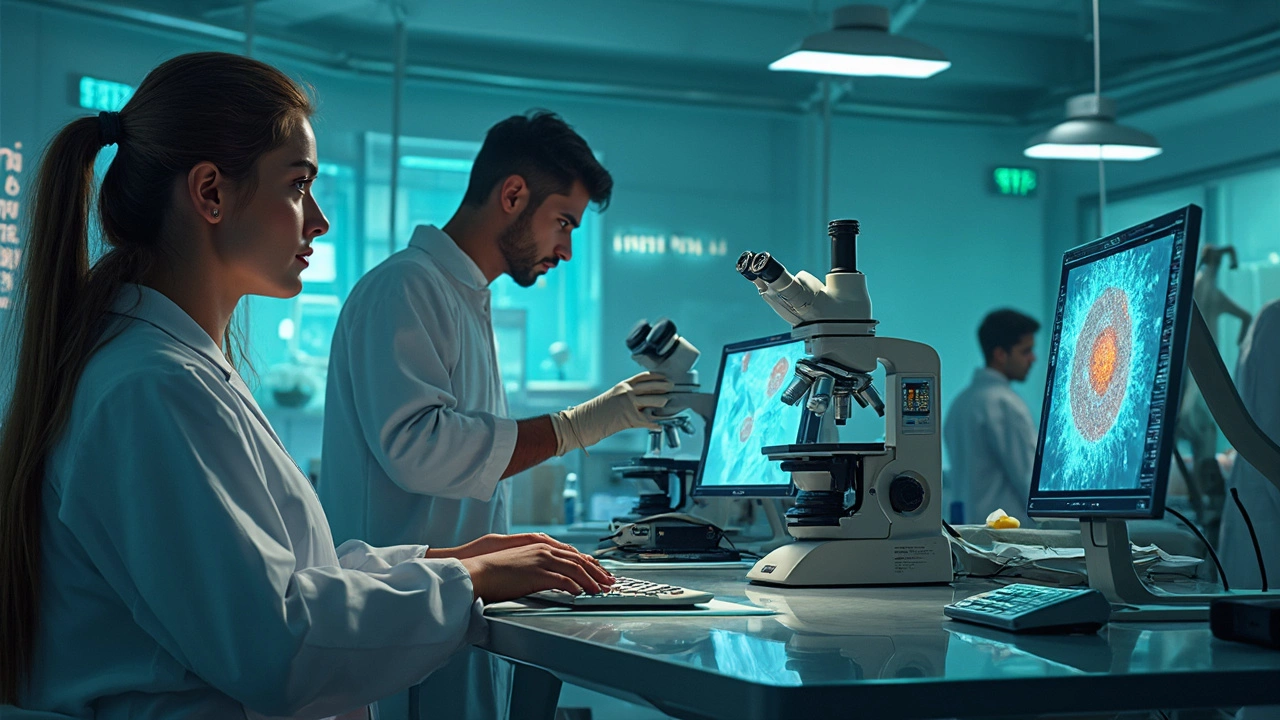
Carcinomas are the heavy-hitters in the cancer world, accounting for approximately 90% of all cases. These are cancers that begin in the epithelial cells—the cells that make up the skin or tissue lining organs. Epithelial cells are everywhere, so it's no wonder carcinomas are so common.
Why is this important for you to know? Well, being aware of carcinomas can help you catch potential issues early, and early detection can make all the difference. There are various kinds of carcinomas, like basal cell carcinoma, squamous cell carcinoma, and adenocarcinoma, and each has its own tale.
One of the first steps in tackling any health issue is understanding it. If you know what you're dealing with, you can take steps to manage or even prevent it. So, let's explore some facts and insights about carcinomas that could be pivotal for you or someone you know.
Understanding Carcinomas
When we talk about carcinomas, we're looking at cancers that start in the epithelial cells. These are the cells that cover internal and external surfaces of the body. So, it's a bit like saying, "Hey, this is where most cancers like to kick off their shenanigans."
These cancers are not only the most common but also come in different flavors. The key types of carcinomas include basal cell carcinoma, squamous cell carcinoma, and adenocarcinoma. Each has its unique features and favorite spots to show up on or in your body.
Why Epithelial Cells?
Epithelial cells are basically everywhere. They line your organs, skin, and ducts. Their high turnover rate, because of constant wear and tear, makes them prime real estate for cancer. That's one reason why they're often implicated in about 90% of all cancer cases.
The Main Players
Let's look at the big three:
- Basal Cell Carcinoma: Mostly shows up on the skin, especially areas with a lot of sun exposure. It's the most common type but also usually less aggressive.
- Squamous Cell Carcinoma: This one's also a skin favorite but can pop up in other places like the lungs or cervix.
- Adenocarcinoma: Found in the glandular cells—think stomach, prostate, and breast tissue.
Here's a quick glance at their prevalence rates:
| Type | Approx. % of Skin Cancer Cases |
|---|---|
| Basal Cell Carcinoma | 80% |
| Squamous Cell Carcinoma | 16% |
| Adenocarcinoma | N/A (varies based on organ) |
Being familiar with these types and understanding their quirks is a crucial first step. It gives you the knowledge to recognize what might be happening in your body and when to get it checked out by a pro. Remember, knowledge is not just power—it's your best tool for staying ahead of the game.
Types of Carcinomas
When talking about carcinomas, knowing the types can help guide effective treatment and management. There are several categories worth noting, each with its own characteristics and implications for health.
Basal Cell Carcinoma (BCC)
BCC appears most often on skin exposed to the sun. It's the most common form and usually grows slowly, often manifesting as a shiny bump or a scar-like area. While it’s less aggressive than other types, early attention can prevent complications. Sun protection is key to lowering risk.
Squamous Cell Carcinoma (SCC)
Generally arising on sun-exposed areas like the face and hands, SCC can show up as a red nodule or a rough patch. It's a bit more aggressive than BCC and has the potential to spread if left unchecked. Regular skin checks are crucial.
Adenocarcinoma
This type forms in mucus-producing glandular cells and can affect organs like the lungs and the colon. Lung adenocarcinoma is actually the most common type of lung cancer. These carcinomas can be sneaky, so knowing family history and staying alert to unusual symptoms helps.
Transitional Cell Carcinoma
Found in the urinary system, such as the bladder and kidneys, transitional cell carcinoma is known for starting in cells that can change shape and stretch. Pay attention to any noticeable changes in urination habits.
| Type | Common Area | Aggressiveness |
|---|---|---|
| Basal Cell Carcinoma | Skin (sun-exposed) | Less aggressive |
| Squamous Cell Carcinoma | Skin (sun-exposed) | Moderately aggressive |
| Adenocarcinoma | Glands/lungs | Variable |
| Transitional Cell Carcinoma | Urinary organs | Variable |
Knowledge of these types is more than academic—it’s life-saving. Awareness boosts vigilance, enabling timely consultations and interventions, fostering better outcomes. So, next time you're at the doctor’s, ask about these, especially if anything seems off or if you have a family history.

Treatment Options
When it comes to dealing with carcinomas, understanding your treatment options is crucial. There's no one-size-fits-all approach, but there are several common methods that doctors often use, depending on the type and stage of the cancer.
Surgery
For many types of carcinomas, surgery is the go-to. It's often the most direct way to remove the cancer. Surgeons aim to cut out the tumor and a bit of surrounding tissue to make sure they've got all the nasty stuff. It's like getting rid of a weed with its root. If the carcinoma is caught early, surgery alone might be all you need.
Radiation Therapy
Then there's radiation therapy. It uses high-energy rays to target and destroy cancer cells. If surgery isn't an option, radiation can be a good alternative. Sometimes, it’s used alongside surgery to shrink tumors before removal or to kill off any leftover cells afterward.
Chemotherapy
It wouldn’t be a cancer discussion without mentioning chemotherapy. This treatment uses drugs to destroy cancer cells. Unfortunately, it doesn’t just target the cancer, which means side effects are pretty common. However, it can be effective for some carcinomas, especially those that have spread.
Immunotherapy
Here's where things get a bit more high-tech. Immunotherapy is all about boosting the body's immune system to fight off cancer. Basically, it gives your natural defense system a bit of a supercharge.
Targeted Therapy
This one's more of a precision strike. Instead of going after all fast-dividing cells, targeted therapy goes after specific markers in cancer cells. There’s a bit of science magic involved, but it can be a game-changer for certain carcinomas.
Each of these therapies comes with its own pros and cons, and not every option suits every patient. It’s crucial to talk with oncologists about the best course of action based on individual circumstances.
| Carcinoma Type | Common Treatments |
|---|---|
| Basal Cell Carcinoma | Surgery, Radiation |
| Squamous Cell Carcinoma | Surgery, Radiation, Chemotherapy |
| Adenocarcinoma | Chemotherapy, Targeted Therapy |
Remember, being part of the decision-making process about your treatment can offer some sense of control and a bit of peace of mind.
Prevention Tips
Preventing a disease like carcinomas isn't always straightforward, but knowing what to do can definitely boost your chances of staying healthy. Let's tackle some tips that might help you keep these common cancers at bay.
Stay Sun Safe
Skin carcinomas, like basal cell and squamous cell, love the sun. To keep them away, protect your skin from UV rays. Wear sunscreen with SPF 30 or higher even on cloudy days, and reapply every two hours. Cover up with clothes, hats, and sunglasses when the sun's blazing.
Kick the Tobacco
Tobacco smoke is a major player in causing different types of carcinomas, especially lung cancer. Quitting smoking decreases your risk significantly. Need help quitting? Consider seeking support from cessation programs or helplines.
Mind Your Diet
Your diet can either be a friend or a foe in cancer prevention. Eat lots of fruits, vegetables, and whole grains while cutting back on red and processed meats. A balanced diet not only supports your overall health but can reduce your cancer risk too.
Regular Check-Ups
Early detection is key. Regular health screenings can catch carcinoma signs early when they're easiest to treat. Keep up with recommended check-ups and discuss any unusual changes in your body with your doctor ASAP.
Limit Alcohol Intake
Excessive drinking is linked to several cancers, including liver and esophageal. Limit your alcohol intake to one drink a day for women and two for men, or skip it altogether if you're feeling extra cautious.
| Lifestyle Choice | Impact on Carcinoma Risk |
|---|---|
| Sun Exposure | High Risk Without Protection |
| Tobacco Use | Increases Risk Significantly |
| Healthy Diet | Decreases Risk |
| Alcohol Consumption | Increases Risk with Excess |
Being proactive about these choices can be your shield against carcinomas. Implementing these habits isn’t just about reducing cancer risk—it's about living a healthier, more conscious life!
Categories
Popular Articles

Mar 3 2025

Mar 1 2025





